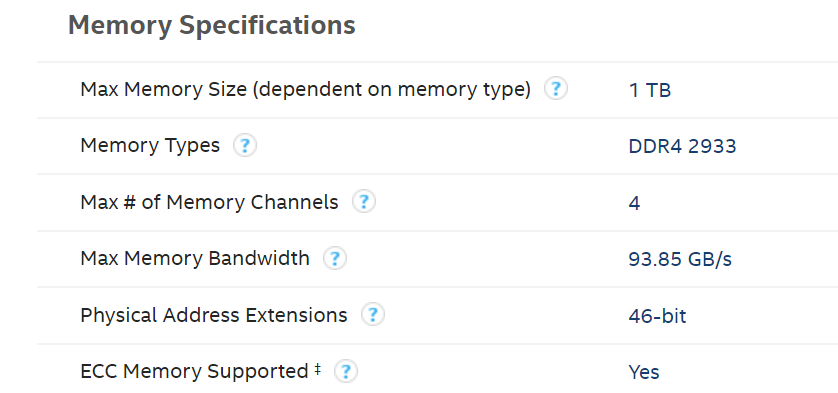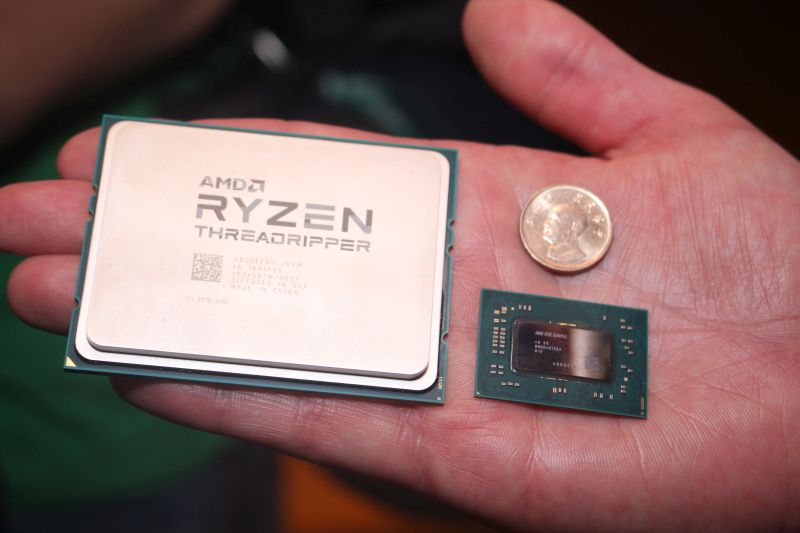Intel introduced a new line of Xeon processors. They are cheaper than earlier models, but still at 14 nm
Over the past week, Intel announced several processors of the new Intel Xeon W-2200 line for professional use on workstations and servers.

In short, then:
* - there is a catch, see under the cut.
** - The older model Intel Xeon W-2200 series has the index W-2295. Now the network is actively indexing that the older model has the W-2285 index, but such a processor does not exist in nature, which confirms the official list of W-series processors on the manufacturer’s website . This error was launched by some inattentive journalist (the W-2285 processor is already google even in Japanese).
*** - in comparison with the previous line of processors of this family.
The new W-2200 series will go on sale in the 4th quarter of 2019 at a price of $ 294 to $ 1,333 per product.
And now let's talk in more detail about what the “blues” showed us. First of all, here is a complete table of the main characteristics of each of the eight new processors in the W-2200 line:

Regarding the madhouse, a separate clarification should be made in the “frequency” column. Now, engineers (although rather marketers) Intel do not simply indicate the minimum and maximum possible frequency within the factory settings of the processor. So, the table shows 4 types of frequencies.
The first is the base frequency of one core.
The second is the maximum frequency when all the cores work simultaneously.
The third is the maximum frequency for any one core.
The fourth is the maximum frequency of one of the most productive cores in solo mode when Turbo Boost Max Technology 3.0 factory acceleration technology is activated (apparently, the maximum frequency of the long-suffering CPU0 is implied).
The most adequate curve in terms of increasing frequencies per core for each of the parameters (and the highest base frequency for all cores) from 3.9 GHz in the base and 4.5 GHz on all cores has a quite average and familiar 8-core Intel Xeon W model -2245. But the older “stone” W-2295 with a full load of 18 cores is content with only 3.8 GHz instead of the striking 4.8 GHz. Decide how honestly Intel marketers do.
Among other important things, it is worth noting that all processors support up to 1 TB of RAM. But there’s nothing new either: the W-2200 series processors support the same DDR4-2933 format memory as the W-3200 processors released in the second quarter of 2019. At the same time, the 28-core Intel Xeon W-3275M supports 2 TB of RAM (but it costs ~ $ 7500 against the W-2295 for $ 1333).

The next point to keep in mind is TDP. The declared Intel range is very “hot” - from 105 to 165 W. The question is, what is the amount of heat emission indicated for the base frequencies, so that in the boost the new Intel processors can completely generate twice as much heat and compete with the legendary “electric waffle irons” from "Red" camp AMD. At the same time, the maximum case temperature or TCase-parameter according to the official specification is only 61 ° C for the W-2295, so the option with the new Intel processors cannot be called quiet or easy in terms of cooling.

From the pleasant, it is possible to note the presence of a set of DL Boost instructions, which is used as part of solving machine learning problems. Also in the new processors there is support for the new 2.5-gigabit Intel i225 network controller, Intel vPro platform and Wi-Fi 6 AX200 wireless module.
But what is really good is the price of new processors. Despite their secondary nature in terms of technological solutions against the background of the older W-3200 line and squeezing the last juices out of lithography with a step of 14 nm, the cost of new processors of the W-2200 series cannot but rejoice. The predecessors in the segment - processors of the W-2100 series cost ~ $ 1000 more. The older model W-2195 has a recommended price of $ 2553 against $ 1333 that Intel is asking for for the new Xeon W-2295.
Roughly the same thing happened with the pricing of the new Core i9-10000 consumer series, the cost of which fell to $ 590 for the younger and $ 979 for the older model. Recall that the recommended cost of the flagship of the previous generation - Core i9-9980XE - is $ 1999 according to the manufacturer’s website . On the one hand, the decline is pleasant. On the other hand, it turns out that consumers were overpaying for the line of W-2100, Core i9, and even for the Xeon W-3200, including some fabulous sums, if Intel could just take it, and “drop” the price of its products by half at higher performance new products. Recall that lithography technology is the same everywhere - 14 nm.
It is believed that not the last role in this was played by the latest announcements from AMD, namely, the soon arrival of AMD Ryzen X3950 and its younger models on sale. Intel may also be nervous about the upcoming full-fledged presentation of the Ryzen Threadripper 3000 server series based on the Zen 3 architecture, in which products with 32 and 64 cores are expected.

Photo server Ryzen Threadripper 3000 as part of the announcement this spring
Apparently, the Intel leadership decided that adhering to the overprice policy is banally dangerous: the Reds are advancing on all fronts and are already becoming real competitors where previously only Intel dominated. This is especially true for the consumer and personal workstation segment. In any case, competition is good.
Those who bought previous models of Intel core i9 Extreme or W-2100 processors this year at old prices can only be sympathized.

In short, then:
- the youngest model is 4 cores / 8 threads, the older one is 18 cores / 36 threads.
- The minimum frequency is 3.0 GHz.
- Factory boost frequencies for medium and high models up to 4.7 and 4.8 GHz, respectively *.
- Support 1 TB of RAM throughout the lineup.
- TDP from 105 W on the younger and 165 W on the older CPU **.
- Socket LGA2066.
- Low price***.
* - there is a catch, see under the cut.
** - The older model Intel Xeon W-2200 series has the index W-2295. Now the network is actively indexing that the older model has the W-2285 index, but such a processor does not exist in nature, which confirms the official list of W-series processors on the manufacturer’s website . This error was launched by some inattentive journalist (the W-2285 processor is already google even in Japanese).
*** - in comparison with the previous line of processors of this family.
The new W-2200 series will go on sale in the 4th quarter of 2019 at a price of $ 294 to $ 1,333 per product.
And now let's talk in more detail about what the “blues” showed us. First of all, here is a complete table of the main characteristics of each of the eight new processors in the W-2200 line:

Regarding the madhouse, a separate clarification should be made in the “frequency” column. Now, engineers (although rather marketers) Intel do not simply indicate the minimum and maximum possible frequency within the factory settings of the processor. So, the table shows 4 types of frequencies.
The first is the base frequency of one core.
The second is the maximum frequency when all the cores work simultaneously.
The third is the maximum frequency for any one core.
The fourth is the maximum frequency of one of the most productive cores in solo mode when Turbo Boost Max Technology 3.0 factory acceleration technology is activated (apparently, the maximum frequency of the long-suffering CPU0 is implied).
The most adequate curve in terms of increasing frequencies per core for each of the parameters (and the highest base frequency for all cores) from 3.9 GHz in the base and 4.5 GHz on all cores has a quite average and familiar 8-core Intel Xeon W model -2245. But the older “stone” W-2295 with a full load of 18 cores is content with only 3.8 GHz instead of the striking 4.8 GHz. Decide how honestly Intel marketers do.
Among other important things, it is worth noting that all processors support up to 1 TB of RAM. But there’s nothing new either: the W-2200 series processors support the same DDR4-2933 format memory as the W-3200 processors released in the second quarter of 2019. At the same time, the 28-core Intel Xeon W-3275M supports 2 TB of RAM (but it costs ~ $ 7500 against the W-2295 for $ 1333).

The next point to keep in mind is TDP. The declared Intel range is very “hot” - from 105 to 165 W. The question is, what is the amount of heat emission indicated for the base frequencies, so that in the boost the new Intel processors can completely generate twice as much heat and compete with the legendary “electric waffle irons” from "Red" camp AMD. At the same time, the maximum case temperature or TCase-parameter according to the official specification is only 61 ° C for the W-2295, so the option with the new Intel processors cannot be called quiet or easy in terms of cooling.

From the pleasant, it is possible to note the presence of a set of DL Boost instructions, which is used as part of solving machine learning problems. Also in the new processors there is support for the new 2.5-gigabit Intel i225 network controller, Intel vPro platform and Wi-Fi 6 AX200 wireless module.
But what is really good is the price of new processors. Despite their secondary nature in terms of technological solutions against the background of the older W-3200 line and squeezing the last juices out of lithography with a step of 14 nm, the cost of new processors of the W-2200 series cannot but rejoice. The predecessors in the segment - processors of the W-2100 series cost ~ $ 1000 more. The older model W-2195 has a recommended price of $ 2553 against $ 1333 that Intel is asking for for the new Xeon W-2295.
Roughly the same thing happened with the pricing of the new Core i9-10000 consumer series, the cost of which fell to $ 590 for the younger and $ 979 for the older model. Recall that the recommended cost of the flagship of the previous generation - Core i9-9980XE - is $ 1999 according to the manufacturer’s website . On the one hand, the decline is pleasant. On the other hand, it turns out that consumers were overpaying for the line of W-2100, Core i9, and even for the Xeon W-3200, including some fabulous sums, if Intel could just take it, and “drop” the price of its products by half at higher performance new products. Recall that lithography technology is the same everywhere - 14 nm.
It is believed that not the last role in this was played by the latest announcements from AMD, namely, the soon arrival of AMD Ryzen X3950 and its younger models on sale. Intel may also be nervous about the upcoming full-fledged presentation of the Ryzen Threadripper 3000 server series based on the Zen 3 architecture, in which products with 32 and 64 cores are expected.

Photo server Ryzen Threadripper 3000 as part of the announcement this spring
Apparently, the Intel leadership decided that adhering to the overprice policy is banally dangerous: the Reds are advancing on all fronts and are already becoming real competitors where previously only Intel dominated. This is especially true for the consumer and personal workstation segment. In any case, competition is good.
Those who bought previous models of Intel core i9 Extreme or W-2100 processors this year at old prices can only be sympathized.
All Articles